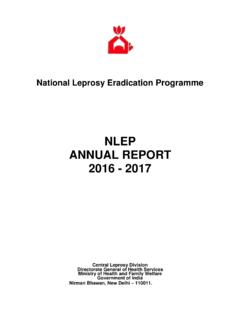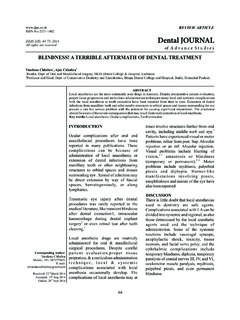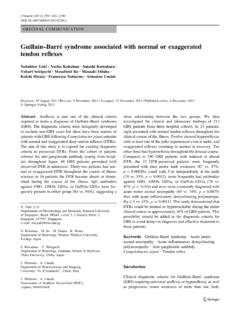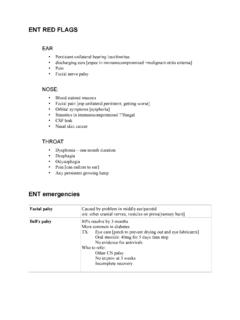Transcription of Disability Prevention & Medical Rehabilitation
1 VakilsJuly 2012 Printed by Novartis Comprehensive Leprosy Care Association, Mumbai, India as a Scientific Service to Medical & Paramedical Leprosy Eradication Program Central Leprosy DivisionDirectorate General of Health Services, Ministry of Health & Family Welfare, Government of India Nirman Bhavan, New DelhiGuidelines for Primary, Secondary and Tertiary Level Care Disability Prevention & Medical RehabilitationMahatma Gandhi nursing Parchure Shashtri, the great Sanskrit scholar who suffered from leprosyNational Leprosy Eradication Program Central Leprosy DivisionDirectorate General of Health Services, Ministry of Health & Family Welfare, Government of India Nirman Bhavan, New DelhiGuidelines for Primary, Secondary and Tertiary Level Care Disability Prevention & Medical RehabilitationContentsClinical Aspects 11 DPMR Aspects 24 Implementation of DPMR services at Primary level 45 Implementation of DPMR Services at Secondary Level 63 Implementation of DPMR Services at Tertiary Level 77 Annexures of forms 92 Novartis has been in the forefront of the fight against leprosy and has a long-term commitment to leprosy treatment and control that goes back 25 years.
2 Since 2000, Novartis has donated more than 48 million multi-drug therapy blister packs through the World Health Organisation, helping cure over 5 million leprosy patients all over the world. India, with the highest case load, is the largest continues to attract stigma due to the ensuing Disability that follows delayed treatment and Novartis has been advocating the cause of these patients through several initiatives in India and elsewhere. India is home to nearly half a million disabled persons afflicted with leprosy. For over two decades now, the Novartis Comprehensive Leprosy Care Association had been actively involved in developing innovative, affordable and sustainable solutions for the problems that affect persons suffering from leprosy. Among these are specially prefabricated splints, self-care kits and grip-aids that play a contributory role in restoring independence. Reconstructive surgery plays a major role in reinstating the dignity of people impacted by leprosy and minimizing the stigma.
3 Reaching Disability Prevention and Medical Rehabilitation to those in need calls for defining the roles and responsibilities of people at all levels of healthcare. The publication of this book on Disability Prevention and Medical Rehabilitation Guidelines is an attempt towards this. We at Novartis feel humbled that Dr Atul Shah, Director, Novartis Comprehensive Leprosy Care Association, was selected as member of the Committee responsible for revising the would like to thank the Government of India on behalf of all of us at Novartis, the Novartis Foundation for Sustainable Development and the Novartis Comprehensive Leprosy Care Association for recognizing our role in the fight against leprosy and for giving us the opportunity to publish these guidelines as our contribution in the efforts to eradicate leprosy through the National Leprosy Eradication Program (NLEP).It will always be our endeavor to work jointly with the Government to remove the social stigma associated with this disease.
4 All good wishesRanjit ShahaniJune 2012 Operational Guidelines for DPMR9 National Leprosy Eradication ProgramIntroductionNational Leprosy Eradication Programme (NLEP) is implemented with major objectives of reducing the disease burden, preventing disabilities and to improve awareness about leprosy in the country through general health care Drug Therapy is still considered as most potent drug regimen to reduce the burden of leprosy by interrupting transmission of disease and curing all registered cases of leprosy and making them released from treatment within shortest possible time. India has achieved the milestone of leprosy elimination since Dec. 2005 with wider use of MDT. But still a considerable numbers of new cases are being detected every year with Disability and deformity. There also exists large number of cases who have completed the full course of MDT but have got different types of deformities and Disability due to consequences of permanent nerve damage.
5 Amongst the leprosy cured there are some of them though presently do not have any deformity but may develop same due to negligence in taking care of their anesthetics eye, hand or feet. As now the vertical program has been integrated into general health care system, it has become the responsibility of general health care system not only to ensure early case detection and provide regular MDT but also carry out all the activities required to prevent Disability and provide Medical rehabilitative services to patients who require the leprosy services like diagnosis & multi drug therapy, drug procurement and simplified information system have been well established in general health care system starting from sub center to district HQ hospitals and tertiary health care institutions. The Disability Prevention and Medical Rehabilitation services are comprehensive care to be provided to all old and new Disability cases of leprosy so that they will not worsen their condition.
6 It is estimated that around one million leprosy patients with disabilities exist in the country. There will be an average of 2000 to 3000 cured leprosy patients with disabilities living in a district. To institute care for individual leprosy patients with disabilities, it is essential to identify each patient having Disability / deformity due to leprosy and motivate them to avail services at nearest CHC. Block CHC will be identified as first referral center for provision of DPMR is felt that Prevention of deformities and disabilities need to be given higher emphasis during the 12th Five Year Plan period (2012-2017). NLEP Mile-stones1952Dr. Wardekar s SET pattern for Survey Education and Treatment1955 National Leprosy Control Program launched1981 MDT (multidrug therapy) recommended by World Health Organisation as cure1983 National Leprosy Eradication Program launched1991 World Health Assembly adopts resolution to eliminate leprosy by the year 2000.
7 Elimination was defined by WHO as prevalence of less than 1 per 10,000 population1993 World Bank assisted the NLEP2004 Leprosy integrated with GHS (general Health Service)2005 Leprosy elimination achieved at the National level in India2006 DPMR introduced as a component of NLEP2007 Disability Prevention & Medical Rehabilitation Guidelines for primary, secondary and tertiary level distributed by NLEP 2011 Guidelines on DPMR for NLEP revisedNational Leprosy Eradication ProgramOperational Guidelines for DPMR 10 New Goal by WHOTo decrease the rate of disabilities in new cases among 10 lacs population by 35% with compare to the base line of 2010. New IndicatorTo decrease the visible disabilities to less than 1 per 10,000,00 population in the community by DPMR activities are planned to be carried out in a three-tier system the Primary level care (First level), Secondary level care (Second level) and the Tertiary level care institutions (Third level).
8 The Primary level care are going to be started from village or community level to Community Health Center (CHC) level in rural areas, Sub-Divisional Hospitals and Urban Leprosy Centers /dispensaries in the urban areas. DPMR OPD/ clinic will be established at CHC and sub-divisional hospitals by trained leprosy paramedical worker under the guidance of MO in charge. OPD/clinic will function daily during the normal OPD timing within the premises of health institution. Secondary level care centers include district hospitals and district nucleus team. At some places secondary level care is available in the NGO supported leprosy units. The tertiary level refers to few centers of excellence where complicated cases can be referred from primary or secondary level. Besides, tertiary care for management of deformities is available at Medical colleges and RCS centers recognized by Government of is important to remember that the important factor for continuing stigma is the deformities.
9 It is not necessary that Disability means patient has visible deformity for example inability to feel hot and cold due to anesthesia is a Disability without any visible deformity. In the same way Medical fraternity believes any therapy whether Medical or surgical which is able to prevent the occurrence of Disability or recovery in sensation or motor power is termed as Disability Prevention . However, general health services in broad definition of POD, also includes measures to prevent the worsening of existing Disability or deformity and Prevention of secondary impairments like joint contractures in claw hand or ulcer occurring in an anesthetic foot. Thus, offering MCR (microcellular footwear) is considered a modality for Disability Prevention . Care at all levels needs to look at not only healing of the ulcer but also prevent operational guidelines which follow are expected to guide different health personnel, community level functionaries, people affected with leprosy (PAL) and also tertiary care institutions to play their role in Disability Prevention , correction and care for all leprosy affected Guidelines for DPMR11 National Leprosy Eradication ProgramConfirmation of diagnosisMajority of leprosy cases can be diagnosed clinically by eliciting cardinal signs of leprosy.
10 However, some cases of leprosy do not manifest with visible skin patches or nodules but present with changes in the skin like redness, swelling and mild thickening of skin. Such cases with infiltration of the skin are generally multi-bacillary with positive skin smears. They represent what is called as the leprosy of consequence as they transmit the disease before adequate treatment is initiated. In such cases slit skin smear examination will help in confirmation of diagnosis. On the other hand some of the cases of leprosy manifest with thickening or enlargement of peripheral nerves with sensory or motor impairment along the course of affected nerves. Careful sensory motor testing in the area supplied by the thickened nerve will help in confirmation of the diagnosis. Sometimes, electrophysiological studies or nerve biopsy may be indicated to rule out other cases presenting with planter ulcer, anaesthesia without any other evidence of leprosy must be examined carefully with detailed history and investigations for spinal lesions like meningomyelocoele in childhood or spina bifida etc.










